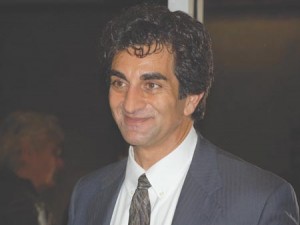Ruzan Orkusyan
Staff Writer

Photo: Erica Magarian
It is said that a picture is worth a thousand words and Matthew Karanian’s presentation “The Armenians of Jerusalem: A Photographic Journey” certainly proved this. He gave a magnificent photographic tour of the Armenian quarter of the walled Old City of Jerusalem as well as some of the other quarters within Jerusalem. Each photo captured the spirit, culture, beauty, and charm of the city.
A standing-room only audience attended the March 30th lecture sponsored by the Armenian Studies Program. Some were able to visually visit the Old City for the first time through the photographs, while for some, who had once lived in Jerusalem, it brought back sweet memories of the past as they revisited familiar sights.
Karanian, a Pasadena lawyer, has spent most of the last 15 years working and living in Armenia. He has promoted travel to Armenia by publishing travel guidebooks such as Armenia and Karabagh: The Stone Garden Guide. This was a result of a gradual increase in Karanian’s cultural self-awareness and a desire to encourage others to likewise develop it. However, it became increasingly evident to him that the Armenian nation was so much more than the Republic of Armenia; it included all the Armenian Diasporan communities across the globe.
Karanian’s lecture focused on one of the oldest Armenian communities outside of Armenia, the 2,000 year old Armenian Quarter of Jerusalem. He took his first trip to Jerusalem ten months ago and lived among the Armenians – working, interviewing, and photographing. Throughout his journey he uncovered the rich cultural legacy of the Armenian Quarter. That knowledge, as well as the breathtaking photos, was shared with an audience that was mesmerized by the beauty and history of the Quarter.
He took the audience step-by-step, street-by-street through the alleys of old Jerusalem, through the different quarters of the walled city and the magnificent sites associated with the life of Jesus. Karanian emphasized the scope and power of the Armenian Apostolic Church, which administers at least a part of every major Christian Holy Site in the region, including but not limited to Bethlehem, the birthplace of Christ, the Holy Sepulchre where Jesus was crucified and was resurrected, and the Tomb of the Virgin Mary. He commented that the role played by the Armenian Church, a small national church, is astonishing.
Karanian highlighted the rich and prominent Armenian culture through examples of Armenian architecture, early Armenian writing in mosaics, and authentic Armenian ceramics shops. In the end he remarked that after his first journey to the Old City he felt more Armenian. He was proud of what the Armenians had and specifically the ability of the Armenian Church to rival the Greek and Catholic Churches in its dignity and wealth.
This snapshot of Jerusalem, the Armenian Quarter as well as other quarters, provided the illusion of having traveled there and back. Everyone was fascinated by the history and the stories that Karanian told which accompanied each equally captivating photograph. After the lecture, many of the older audience members shared their own experiences and memories, while the youth were inspired to someday take their own journey to the culturally and spiritually rich Armenian Quarter.
 Hye Sharzhoom Armenian Action
Hye Sharzhoom Armenian Action